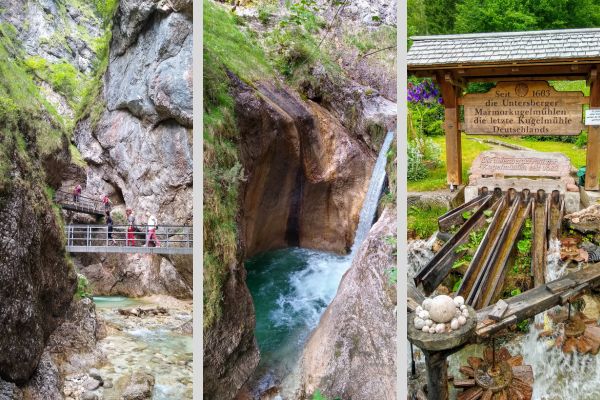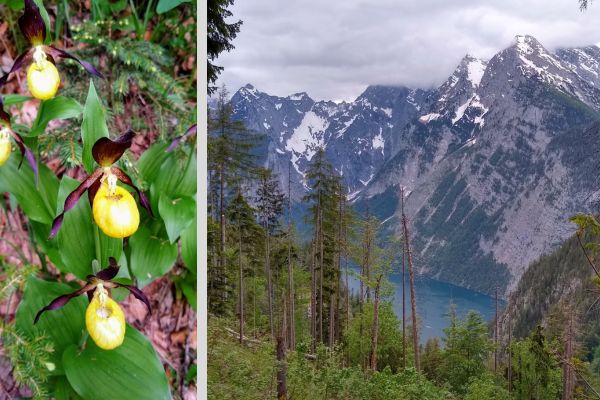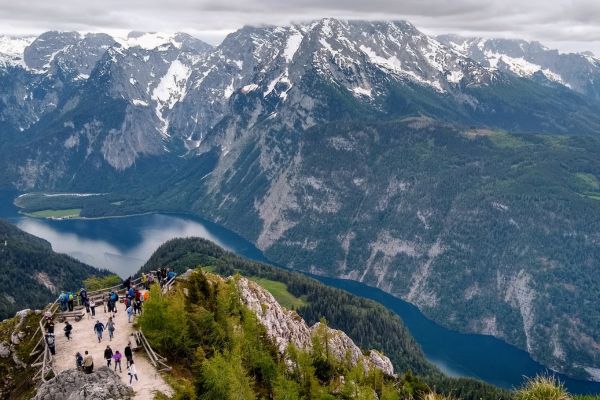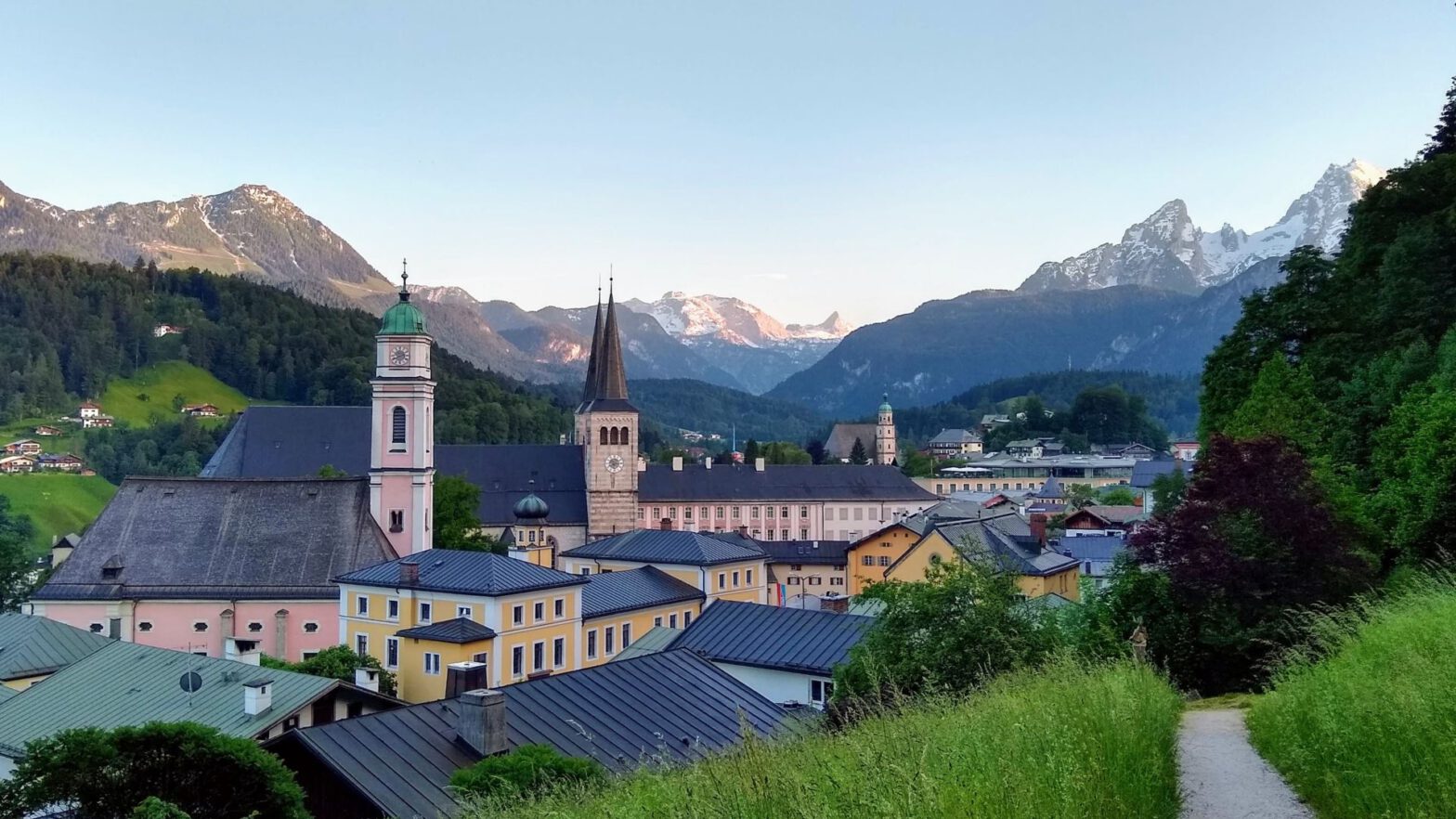A popular day trip from Munich takes visitors to Berchtesgaden, Obersalzberg and Eagle’s Nest in the southeastern-most corner of Germany. This is a beautiful area called Berchtesgadener Land that deserves more than a passing visit. Find out how to do this trip on your own – it’s easy!
In this mini-guide, you will find information about the main sights in and around Berchtesgaden, as well as suggested itineraries.
What to See In and Around Berchtesgaden
Besides stunning scenery and picturesque villages and towns, Berchtesgaden is home to two sites that are connected to the Nazi history.
Obersalzberg
Obersalzberg was originally a mountain village. Hitler liked the area and purchased a house there that would become the Berghof, his residence and secondary government seat. Obersalzberg became a restricted zone that was not publicly accessible.
After the war and until 1996, the site was used by the US Army as a Recreation Site for its soldiers stationed in Europe.
In 1999, the NS Documentation Center was opened.
From Berchtesgaden train station, catch bus 838 to stop „Dokumentation Obersalzberg“ to visit Obersalzberg.
Eagle’s Nest/Kehlsteinhaus
High above Berchtesgaden sits the Eagle’s Nest. It is one of the few Nazi era buildings that were neither damaged in the war nor blown up afterwards.
It seems that Hitler did not spend much time here – in terms of Nazi history, Obersalzberg is the more important location. Eagle’s Nest is at almost 6,000 feet elevation and not accessible year-round.
To get to Eagle’s Nest, you have to catch a special ($$$) bus from near Obersalzberg. Check the Eagle’s Nest website for details.
Königssee (King’s Lake)
One of the most beautiful Bavarian lakes, King’s Lake is just a few miles from Berchtesgaden. Catch bus 840, 841 or 843 towards „Königsee“, then try and make up your mind whether you prefer to walk along the shore, take a scenic boat ride, or approach the summit of Jenner mountain by cable car.
Other Sights
The entire area is heavily defined by salt. „Salzburg“ means „salt castle“. Anything „hall“, such as Bad Reichenhall or Hallstadt, also indicates a salt connection.
The Berchtesgaden Salt Mine is in the valley, by the river.
The old Salt Works are located in the town of Bad Reichenhall. To get there, you can catch the S-Bahn or a bus from Berchtesgaden (S-Bahn will be much quicker). „Bad Reichenhall“ is still a well-known brand for kitchen salt in Germany. Needless to say, you can purchase their products in their shop – or in any supermarket.
Berchtesgaden has a nice (not totally amazing) thermal spa, the Watzmann Therme, with mountain views. The spa in Bad Reichenhall is called Rupertus Therme.
At Marktschellenberg, there is Germany’s oldest marble-ball mill. Start the Almbachklamm walk from here.

Watzmann Views
The iconic Watzmann peaks can be seen from town and from the thermal spa.

Do not attempt to hike or climb this mountain unless you are experienced and well-prepared mountaineers! The mountain is treacherous and especially the East face is claiming lives.
Suggested Itineraries for the Berchtesgaden Area
Two Days – The Main Sights
On day 1, leave Munich in the morning. Arrive in Berchtesgaden in time for lunch and to check in to your accommodation. In the afternoon, explore the town and the salt mine, perhaps even visit the thermal spa. Enjoy the alpine sunset.
On day 2, set out early to visit Obersalzberg and/or Eagle’s Nest. Head back to Munich or on to your next destination in the afternoon. Salzburg is just around the corner if you are visiting Austria – you can go there by bus from Berchtesgaden.
With More Time – Add Nature
On day 1, leave Munich on the morning train. Arrive in Berchtesgaden in time for lunch and to check in to your accommodation. In the afternoon, explore the town and the salt mine. Enjoy the alpine sunset.
On day 2, set out early to visit Obersalzberg and/or Eagle’s Nest. To decompress, visit the Watzmann Therme in the afternoon.
On day 3, catch a bus to Schönau am Königssee. Königssee, the King’s Lake, is a beautiful lake in stunning scenery. There is no trail or road leading around the entire lake, but it is possible to walk a little path to Malerwinkel (ca. 20 minutes).
You can swim in the lake, but the water is cold. As the boatmen like to joke, „You go in a king, you emerge a princess.“ Air mattresses and dinghies are not allowed.

To really enjoy the views of the lake and surrounding mountains, catch a boat. You are treated to amazing scenery as well as a little trumpet concert where the boat staff demonstrate the famous echo (have some small change handy as a tip). Make sure to buy a return ticket and to check the boat schedule, especially if you are taking an afternoon boat!
As part of the boat ride, you can visit the pretty little church of St. Bartolomä. For some exercise, hike from the Salet stop to Obersee (approx. one hour). At Obersee, you will also be able to see the Röthbach Falls, Germany’s tallest waterfall. If you step off the boat at Kessel, you will have to return to Schönau along the eastern lakeshore. The hike is beautiful and fairly easy, but can be pretty exhausting. Hiking gear is essential on both hikes.

In addition, or alternatively, you could take the Jennerbahn cable car (or hike to the Jenner summit). The summit station is at 1,800 metres/approx. 6,000 feet elevation. When I was there in 2019, the cable car had just reopened after renovations, and a round-trip ticket cost only 10 €. Bargain! 🥳 In 2025, a regular ticket is 45 €.

You can spend many more days in the area, which has amazing hikes. I really enjoyed:
- Halsalm from Hintersee (not very difficult, but requires hiking boots, a sense of orientation and some mountain experience)
- Almbachklamm (gorge walk with some stairs)
- Wimbachklamm (an easy gorge walk suitable for children)

The best-known, and also most dangerous, summit is Watzmann. (Fatal) Accidents are common, so you should only undertake this hike if you are an experienced mountaineer and have the equipment. Check the German Alpine Club’s website for initial information.
If you would like to go farther afield, take an easy day trip to Salzburg (there are direct buses), or visit Herrenchiemsee Palace on Lake Chiemsee. The latter is another castle built by King Ludwig II., who gave us Neuschwanstein.
Finally, head back to Munich or on to your next destination.
How to Get to Berchtesgaden
Take a Salzburg-bound train from Munich central or East station to Freilassing. In Freilassing, change to the S-Bahn towards Berchtesgaden. You can do this trip on the Bayern-Ticket if you use the regional trains. For the EC, RJ or WB trains, you need a standard ticket.
If travelling from Salzburg, catch a train or S-Bahn to Freilassing (bring your passport!) and change to the S-Bahn bound for Berchtesgaden. There are also direct buses from Salzburg.
Where to Stay in the Berchtesgaden Area
The most convenient accommodation will be in Berchtesgaden, easily reached by train. Bad Reichenhall, a few minutes away by train, may be slightly cheaper. It is also flatter and will therefore be easier to navigate if you have issues with ascents and descents.
When booking accommodation, note that Berchtesgaden and all the other towns sit in a valley. Berchtesgaden is a steep place. The town square is already at a higher elevation than the train station. The walk into town can be long and slow.
Some of the farmhouse accommodation (often called „Lehen“ or „Leiten“) will be at an even higher elevation. You will need a car (or taxi) to stay there – „1 mile from the centre“ may be a very long and exhausting walk.
If you have mobility issues and are using public buses, make extra sure to check where your accommodation is located and how you will be able to get there and back into town. Check on Google Maps whether there is a bus stop near where you are staying. Keep in mind that buses may run at one-hour intervals.
All buses serving Berchtesgaden stop at the central bus interchange next to the Berchtesgaden train station. Many but not all also stop along the main road leading through town. Staying near the train station is not necessarily an ideal solution. You will miss the town centre and food options are limited.
Hotel Suggestions for Berchtesgaden
The fanciest digs will be at Kempinski Hotel Berchtesgaden. This luxury hotel is located outside the town and near the Obersalzberg. Getting here will be a bit of a drag without a car or taxi.
If you prefer to stay near the train station, Hotel & Restaurant Schwabenwirt gets good reviews. The rooms are pretty standard German-style and come with private bathrooms. The hotel does sit right on a large roundabout, so there will be traffic noise.
Hotel Edelweiss Berchtesgaden has a spa and is right in the centre of town.
I stayed at Ederhaus (self-catering apartments) in 2019. Nice, but I was panting every time from the steep ascent. The apartments seem to have been renovated since.
Where to Eat
You pretty much can’t go wrong in any of the traditional Bavarian restaurants. The menu will feature all the usual classics such as pork roast, pork shank, schnitzel, sausages and Leberkäse. Of course, you will also find the ultimate German classic, doner kebab 🤣, in Berchtesgaden as well as a Burger King.
The Bäcker-Brüder Marktcafe is a great spot to pick up pastries for breakfast and sandwiches for hikes.
For chocolate, cakes and ice cream, head to Berchtesgadener Schokoladenmanufaktur (cash only).
How to Get Around Berchtesgaden
An S-Bahn train runs from the mainline Munich-Salzburg to Berchtesgaden. From there and other towns along the line, there is a very good bus network that can get you to pretty much all the tourist spots. Check the schedules in advance, as lines may not run very frequently, or at all on weekends.
With the „guest card“ issued by your accommodation, you can use all the public buses and trains in the area for free. Make sure to check bus schedules in advance.
You can drive too, but note that, especially in high season, you will almost certainly encounter parking issues. The Berchtesgaden area sits in valleys – there is not much space there.
What to Wear
Berchtesgaden sits at an elevation of about 700 metres/2100 feet. Obersalzberg at 1000 m/3000 ft, and Eagle’s Nest at over 1,800 m/6,000 ft. Thanks to the mountain location, the weather can change quickly. When I visited in May 2019, there was still quite a lot of snow on higher ground.
Therefore, make sure to bring a sweater and a rain jacket, even in summer. The higher up you go, the warmer your clothing should be.
Hiking Gear
If you intend to go hiking, bring hiking boots and ideally hiking poles. Especially in shoulder season, check with the tourist information office about trail conditions.
If you are using hiking apps such as Komoot or Alltrails, remember you may not always have mobile-phone reception in the mountains.
… if you are surprised to read this, you may have less experience than you think. Please take extra care. The mountains can be very dangerous. You are not moving in a controlled environment.

2 Kommentare